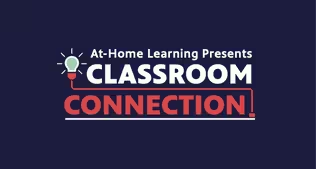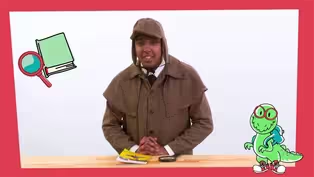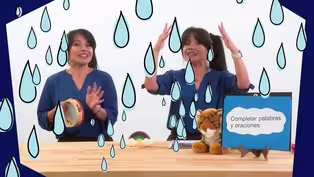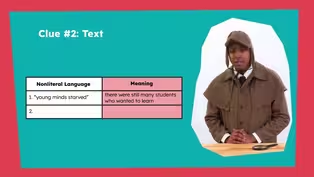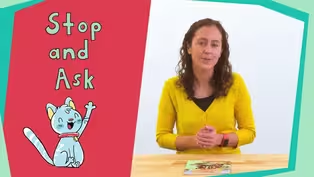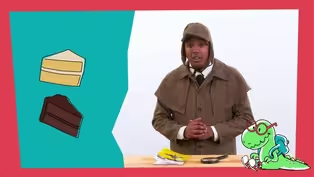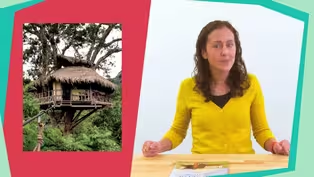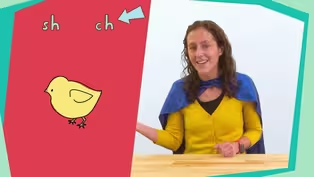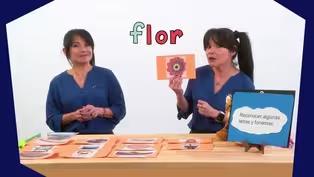
Episode 3 | Literacy Lessons
2/9/2021 | 28m 46sVideo has Closed Captions
Literacy lessons for early learners, led by NC teachers.
The first lesson (aimed at PreK-K learners) helps students retell a simple story and recognize letter Gg and its sound. The second lesson (aimed at 1st-2nd graders) helps learners distinguish the difference between the sound of a long vowel and short vowel sound in a word. Classroom Connection is your At-Home Learning companion where children love to learn. All lessons are led by NC educators.
Problems playing video? | Closed Captioning Feedback
Problems playing video? | Closed Captioning Feedback
At-Home Learning Presents: Classroom Connection is a local public television program presented by PBS NC

Episode 3 | Literacy Lessons
2/9/2021 | 28m 46sVideo has Closed Captions
The first lesson (aimed at PreK-K learners) helps students retell a simple story and recognize letter Gg and its sound. The second lesson (aimed at 1st-2nd graders) helps learners distinguish the difference between the sound of a long vowel and short vowel sound in a word. Classroom Connection is your At-Home Learning companion where children love to learn. All lessons are led by NC educators.
Problems playing video? | Closed Captioning Feedback
How to Watch At-Home Learning Presents: Classroom Connection
At-Home Learning Presents: Classroom Connection is available to stream on pbs.org and the free PBS App, available on iPhone, Apple TV, Android TV, Android smartphones, Amazon Fire TV, Amazon Fire Tablet, Roku, Samsung Smart TV, and Vizio.
Providing Support for PBS.org
Learn Moreabout PBS online sponsorshipMore from This Collection
Video has Closed Captions
Literacy lessons for early learners, led by NC teachers. (28m 46s)
Video has Closed Captions
Literacy lessons for early learners, led by NC teachers. (28m 46s)
Video has Closed Captions
Literacy lessons for early learners, led by NC teachers. (28m 45s)
Video has Closed Captions
Literacy lessons for early learners, led by NC teachers. (28m 45s)
Video has Closed Captions
Literacy lessons for early learners, led by NC teachers. (28m 46s)
Video has Closed Captions
Literacy lessons for early learners, led by NC teachers. (28m 46s)
Video has Closed Captions
Literacy lessons for early learners, led by NC teachers. (28m 45s)
Video has Closed Captions
Short Description: Literacy lessons for early learners, led by NC teachers. (28m 45s)
Video has Closed Captions
Literacy lessons for early learners, led by NC teachers. (28m 45s)
Video has Closed Captions
Literacy lessons for early learners, led by NC teachers. (28m 45s)
Video has Closed Captions
Literacy lessons for early learners, led by NC teachers. (28m 45s)
Video has Closed Captions
Literacy lessons for early learners, led by NC teachers. (28m 45s)
Providing Support for PBS.org
Learn Moreabout PBS online sponsorship[cheerful upbeat music] ♪ - What's good my good people.
I'm Mr. R and I'm gonna be your guide on today's learning journey.
There's gonna be some twists and some turns but mostly we're gonna have some fun.
[upbeat music] - Hello, super learners.
My name is Miss Jennifer, and I'm so excited that you were here to learn with me today.
You'll need a piece of paper, a pencil, and a stuffed animal for today's lesson.
Ask a trusted adult to help you find these items.
While you're getting your supplies.
I'm gonna grab mine as well.
I'll be right back.
[upbeat music] Okay, I'm back now.
And I see you are too.
We have our supplies, so let's go.
Today, we are gonna reread the story "Puppy paints".
We will practice retelling the story, and review the parts of a book.
We will also review the letter P, and learn about the letter G. Are you ready?
All right, super learners.
Let's get started.
First, let's review the letter P. The letter P looks like this.
Do you remember how to write it?
Show your stuffed friend how to write the letter P in the air.
To write the letter P, we start at the top, make a straight line down, then jumped back to the top, and make a curved line to the right, and back to the straight line, great job.
The letter P makes this sound, [makes sound p] Say it to your friend.
[makes sound p] Now, turn back to me and say it.
[makes sound p] Great job saying the sound p sound.
Now, let's look at our circle map, and see if we can spot words that start with P. We have our pizza.
Tell your friend.
What is the first sound in pizza?
Right, p my pizza is yummy.
How was your pizza?
Tell your stuff friend.
What is the first sound of the word puppy?
Right p, let's pant like a puppy.
[Miss Jennifer panting] Tell your friend.
What is this first sound in paintbrush?
Right p, let's paint together.
My paint is purple.
What color is your paint?
Tell your stuff friend.
What is the first sound in pickle?
Right p, let's eat a pickle.
[chews] Great job, I'm so glad that you remember the letter P, and its sound p. Now, we are gonna learn about the letter G. The letter G looks like this.
To write the letter G, we start at the top, we make a curve line down to the left, then we come back up and slide to the left.
Let's all get out our magic finger.
Use your magic finger in the air to write the letter G with me.
We're gonna start at the top, make a curve line down to the left, then come up and slide to the left.
Great job.
The letter G makes this sound g. Say it to your stuff friend g, g. Now turn and say it to me g, good job saying the g sound.
We're gonna use a graphic organizer called a circle map to help us think about the letter G, and the things that begin with its sound g. You can make your own circle map, using your piece of paper and a pencil or crayons.
First, you're going to draw a small circle in the middle of your paper.
Write what you're thinking about in the circle.
Today, we're thinking about the letter G. So, you should write the letter G in the small circle.
Then you're going to come to the top of your paper, make a large circle around your small circle.
And now you have a circle map.
Super learners, I need your help so that we can fill in our circle map with things that begin with the sound g. I will give you a clue, and you try to guess what I'm thinking.
Are you ready?
Great, I'm thinking of a food that I love to eat that begins with the g sound.
It is a round fruit that comes in a bunch.
Tell your stuff friend what food I'm thinking of.
Did you say grapes?
That's right.
Can you show me how it looks when you eat grapes?
Yum, those were tasty.
Now, I am going to write the word grapes on the circle map.
Grapes, what is the first sound in the word grapes?
That's right, g. Which letter do we need to spell that sound?
That's right, we spelled the sound g with the letter G. Then we need R-A-P-E-S. Now, I'm thinking of something that is part of a fence.
It opens and closes to allow people to go in and out.
Tell your stuff friend what I'm thinking of.
Did you say a gate?
That's right, great thinking.
Can you show your friend how to open and close a gate?
It's kind of like opening and closing a door.
Now, I'm going to write the word gate on the circle map.
Gate, what is the first sound in the word gate?
Did you say g?
That's right g. Tell your stuff friend which letter we need to spell that sound.
That's right, we spell the sound g with the letter G. Then we need A-T-E. That spells gate.
For my last clue, I'm thinking of a color.
It is the color of grass in the spring.
Tell your stuff friend what I'm thinking of.
Did you say green?
That's right, great thinking.
Can you show your stuff friend something green in your home?
Now, I'm gonna write the word green on the circle map.
Green, what is the first sound in the word green?
Did you say g?
That's right, g tell your stuff friend which letter we need to spell that sound.
That's right, we spell the sound g with the letter G. Then we need R-E-E-N. That spells green.
Wow super learners, our circle map looks great.
Look at all those G words that we know.
Thanks for helping.
Now, let's get ready to read our book.
Here is our book.
We read "Puppy Paints" the last time we were together.
Today, we will be using retelling cards to help us retell the story.
A book has several parts.
This part is called the front cover.
It has the title, tells the author and illustrator, and has a picture to show us what story is about.
This is the back cover of the book.
Let's practice to see if you can tell me which is the front cover and which is the back cover.
Tell your stuff friend.
Am I showing you the front cover or back cover?
How do we know?
It has the title, author and illustrator and a picture.
Tell your stuff friend am I showing you the front or back cover?
That's right, this is the back cover.
How do we know?
It does not have the title, author or illustrator on it.
Let's turn the page and read our story.
As we read, pay close attention to two things.
First, listen to what puppy sees and paints.
After we read the story, we're going to remember all of the things puppy sees paints.
Next, if you hear a p sound in your word, touch your ear and tell your friend p. [book opening] Puppy sees a flower.
Puppy paints a flower.
Puppy sees a doll.
Puppy paints a doll.
Puppy sees a cat.
Puppy paints a cat.
Puppy likes his paintings.
We heard a lot of p sounds in that story like puppy and paints.
Now, let's use the retelling cards to tell what happened in the story.
If you forgot something, you can always go back to the story to help you remember.
First, puppy saw a flower.
I'm gonna put the retelling card that shows puppy looking at a flower on the board in the first space.
This retelling card shows the first thing that happened.
Then puppy painted a flower.
I'm gonna put the retelling card showing puppy painting a flower in the next box.
Tell your stuff friend what happened in the next part of the story?
Did you tell your friend that puppy saw a doll?
That's right.
Now, we need our retelling cards showing puppy looking at a doll.
What happened next?
Tell your stuff friend.
Did you say that puppy painted a doll?
That's right.
So ,now we need the retelling cards showing puppy painting a doll.
Let's go back in the story and see what happened next.
Tell your stuff friend what happened in this part of the story?
Did you say puppy saw cat?
That's right.
I'm gonna put the retelling cards showing puppy looking at the cat.
What happened next?
Did you say puppy painted a cat?
That's right.
So, now I need the retelling card showing puppy painting cat.
Now, tell your friend what happened at the end of the story.
That's right.
Puppy liked his painting so much.
He hung them on the wall.
Let's put our picture showing puppy hanging on the wall.
You did such a great job retelling the story.
All right super learners, that is the end of our lesson for today.
Thank you so much for being with me as we reviewed the letter P and learned the letter G. We also learned about the parts of a book.
I hope you enjoyed retelling "Puppy Paints".
Keep looking for the letters, P and G. When you find new P or G words, add them to your circle maps.
I'll see you next time.
- All right, folks.
I'm so full of letters and numbers.
Feels good to know so much, doesn't?
Let's take a break from our lesson, and check out this cool video.
- Hey everyone, it's your boy Jose here and today, we're gonna be learning another hip hop step.
Today's step comes from break dancing, and we're gonna be covering a basic top rock, okay?
This is a really easy step so, I want everyone to follow along.
We're gonna start off by hoping, feet together, hands coming up in this position on the one.
Then I want you to cross step over your foot, two.
Now, as you cross that, I want you to bring your hands out just like this, good job, nice work.
Now, I want you to bring it back.
One, crossed it to the other side, two two, nice work, bring it back.
And we're just following the same rhythm over and over.
Here on the one, stepping out on the two.
Here on the one, stepping out on the two.
If we put a one, two, count to it.
This is one, two, one, two, add the drums.
[sound drumbeats with his mouth] There you go.
Nice, make sure you practice, practice, practice, and I'll see your kids on the next one, peace.
- Hello readers.
My name is Miss Gary, and I'm so excited to be learning with you today.
Before we get started with our lesson, let's say hello with our welcome song.
[cat mewing] ♪ Hello readers ♪ ♪ Hello readers ♪ ♪ How are you ♪ ♪ How are you ♪ ♪ I'm so glad to see you ♪ ♪ I'm so glad to teach you ♪ ♪ Hello you ♪ ♪ You and you ♪ Readers, did you know that all the letters in the alphabet have special names.
They can be put into two categories, consonants and vowels.
Do you know what consonants and vowels are?
Well, there are five main vowels.
The letters A, E, I, O and U, and sometimes Y is a vowel also.
So, let's review our short and long vowel sounds.
So, I love to move my body when I'm learning, do you?
Well, I'm going to crouch down for the short vowel sounds, and stand straight up for my long vowel sounds.
So, let's do it together.
So, stand up and get ready readers.
This is gonna be fun.
So, here comes the first vowel.
The A, the A short sound says a.
The long sound says a.
Here comes the second one.
The E, the E short sound says e, and the long sound says e, great job.
Let's do our next letter vowel, the I.
The short I says i, and the long vowel I says i, great job.
Here comes O.
The short O sound says o, and the long vowel o sound says o.
Here comes our last one, the U.
The short U says u, and the long U says u. Wow readers, that was great.
So, all the other letters, those are called consonants.
Words are made up of both consonants and vowels.
And those letters make sounds.
And those sounds will blend together to form words.
So, in addition to knowing our letter sounds, during each of our lessons, we're going to learn some words.
These words are special, and they're called heart words.
We call these heart words because we're practicing reading them so that we know them by heart or so we don't have to sound them out.
To do this, we're gonna create our very own heart word dictionary.
You're going to need two pieces of paper, and something to write with.
So, while I grab mine, you go ahead and grab yours.
[upbeat music] Okay readers, I'm back.
I have my two pieces of paper, and something to write with.
I grabbed a marker, but it's okay if you grabbed a pen or a pencil or even a crayon.
All right so, let's get to work making our heart dictionary.
I'm going to stack my two pieces of paper, just like this.
And then I'm gonna fold them halfway hamburger style or the short way, just like this.
Wow, will you look at that readers?
I just made a book.
You can do that too.
And our books have covers.
So, I'm going to draw a heart on the front of mine to remind me that this is my heart word dictionary.
Today, we're going to be learning three new heart words to put in our heart word dictionary.
So, let's get ready for our first heart word.
Look at this word.
This is the word about.
Can you say about?
Good, now can you spell it?
A-B-O-U-T, about.
Now, we're going to write our heart word about on the first page of our dictionary.
[paper crumpling] We're gonna write about, A-B-O-U-T, about.
Awesome job readers.
Let's get ready for our next word.
This is the word want.
Can you say want?
Good, now let's spell it, W-A-N-T, want.
Now, we're gonna write the word want on the second page of our heart word dictionary.
So, let's write it.
Want, W-A-N-T, want, great job.
That's the word want.
Let's get ready.
We're working really hard, but we have one more word.
Our third heart word to add to our dictionary.
Look at this word.
This is the word very.
Can you say very.
Great job, let's spell it, V-E-R-Y, very.
Now, we're going to write our third, and final heart word on the third page of our heart word dictionary.
Very, V-E-R-Y, great job readers.
I hope that after this lesson, you'll share this heart word dictionary with someone that you love, and together you can keep adding to your dictionary.
This was a great warm-up readers but now, we're going to learn about a special word pattern in words.
And I can't wait to show you.
In today's lesson, we're going to learn about a very special vowel.
This is the silent E vowel.
We're going to learn one of the many jobs that silent E does when we see this letter at the end of words.
One of its jobs is to make the vowel in the word say the long vowel sound.
To help us learn how silent E works with words, I'm going to bring out my friend silent E. So, silent E has a special job that sometimes allows it to change the sound a vowel makes when it's added to the end of a word with a short vowel sound.
So, let's see how it works.
I'm gonna build a word.
Do you know this what this word is?
I'm gonna tap out the sounds in this word, M-A-D.
This word is mad.
Can you say mad.
Let's listen to the sound that the vowel A makes in the word mad.
A, the A is the vowel and the word mad that makes the short A sound a.
But let's see what happens when I add silent E to the end of the word.
The vowel sound will change.
Let's listen, made.
The e changes from the short A sound, to the long A sound.
So, listen to the word now.
Made, do you notice any difference in the sound?
The letter E turned the short a into the long a sound?
How does E do that?
Because it's one of its jobs in words.
When it comes at the end of a word, most of the time it'll change the short vowel sound to a long vowel sound when it's followed by a consonant at the end of a word.
We're gonna build one more word readers.
This is the word mut.
Can you say mut?
Let's tap out the sounds we hear, M-U-T, mut.
The short U makes the u sound, but what will happen when we add our silent magic E at the end of the word mut.
Mute, the E made the word mute by putting the long u sound in the word mut.
This is the word mute.
So, it's important to remember that one of the jobs of our friend silent E is that when it comes at the end of words, it will make the vowel say its name.
So, let's review the short and long vowel sounds.
Remember, we're gonna crouch down when we hear the short vowel sound and stand up tall when we hear the long vowel sound, are you ready readers?
Here comes A, a.
Long A says a.
Here comes E, short E says e, and long E says e. The short I makes the i sound.
And the long I makes the I sound.
Short O, o, and long O, o.
And one more, the U.
Short U says u, and long U says u.
That was great.
My heart is pumping.
And I'm so excited to use that energy to read words with the silent E pattern.
So, now that we've practiced, and seen how silent E works at the end of words, when it's next to a consonant letter.
Let's see if we can read a couple of sentences, and spot any words that have the long vowel silent E pattern.
Get ready readers.
Here's our first sentence.
Do you like vanilla or chocolate cake?
I see some long vowel, magic silent E words, do you?
Like and cake.
Let's listen to our next sentence.
See if you can spot any words.
Ben rode his bike up the big hill.
I see some more long vowel, magic silent E words.
What do you see?
That's right, I see the word road and bike.
Let's underline them.
And our last sentence, let's read it.
The puppy is cute with the white spots.
Do you see some long, vowel, magic silent E words?
I do too.
I wanna underline the two words, cute and white.
Well readers, today you did an amazing job, identifying words that had the long vowel sound with the silent magic E at the end.
So, when you're reading on your own, and you come across words, remember to practice this skill that you learned today to help you decode those words.
I challenge you to go on a magic silent E walk, and see if you can find any words that have the silent E pattern in them.
So, I hope you had fun today readers, and I'll see you next time.
- Wow, what a great lesson.
I love reading so much.
I'd be like I learned something new each time, do you?
I bet you do.
I can already see your brain looks bigger than it did before the lesson.
Or did you just do something different with your hair?
Either way you're looking smart.
[cheerful upbeat music] ♪
Support for PBS provided by:
At-Home Learning Presents: Classroom Connection is a local public television program presented by PBS NC
